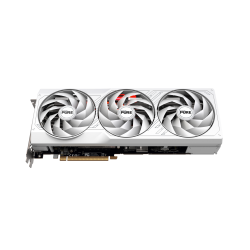
Sapphire Pure Radeon RX 7700 XT 12GB Gaming OC review
In the market, Sapphire's RX 7700 XT PURE has been positioned to fill the void left by the Pulse series and the more expensive Nitro+ series. Unlike the Pulse series, this graphics card has an enlarged heatsink and a third cooling fan. It is overclocked. The model uses an all-white color scheme, which deviates from Sapphire's customary color schemes and follows the trend of using white components in PC builds.
The RX 7700 XT Unadulterated not as it were wanders into the modern stylish region but moreover presents the Navi 32 silicon, a chipset-based GPU that takes after the plan standards of the Navi 31, which is utilized within the RX 7900 arrangement. The Navi 32 keeps up a somewhat diminished arrangement and consolidates AMD's technique of separating components that don't altogether advantage from a 5 nm fabricating handle. Instep, these components are set onto 6 nm chipsets. Such components incorporate the Limitlessness Cache and GDDR6 memory controllers, which dwell on what are known as memory cache passes-on (MCDs). The MCDs house both a 16 MB section of the Interminability Cache and a 64-bit fragment of the 256-bit GDDR6 memory interface, whereas the 5 nm illustrations deal with the center computational and design preparation compute kick the bucket (GCD).
Such highlights position the GPUs to eminently impact the WQHD screen determination portion. In any case, premium execution comes with a cost:
The 7700 XT is estimated at $449, whereas the 7800 XT starts at $499. For our appraisal, we'll be analyzing the 12GB 7700 XT from ASUS as they are dispatched within the Pull Gaming OC version. For a while presently, gossipy tidbits have been flooding the illustrations card field, and as so regularly, most of them ended up as fact. Meet the modern Navi 32-based GPU models. The Radeon 7800 XT with its 16GB 256-bit memory setup at 19.5 Gbps, is bound to inspire. This specific cycle is balanced to utilize the total 60 CU / 3840 Shader processors setup of the GPU and brags an Add up to Board Control (TBP) of 263W. The AMD Radeon RX 7800 XT GPU is built upon the Navi 32 SKU system and in this way chiplets, consolidating four Memory Controller Spaces (MCDs). The GPU center gloats 3840 centers, fastidiously dispersed over 60 Compute Units to upgrade execution. Furthermore, the GPU joins a significant 64 MB Interminability Cache, working at an 18 Gbps stick speed, subsequently yielding a commendable add-up to transmission capacity of 576 GB/s. The moment Navi 32 variation, aka Radeon RX 7700 XT, sees a neighborly 54 CU/3456 shader processor setup, complemented by 12GB memory on a 192-bit transport running at a viable 18 Gbps information rate. This focuses on a Navi 32 cycle with one of the four MCDs crippled, coming about in 48 MB of Interminability Cache. The center setup of the RX 7700 XT is expected to include roughly 54 Compute Units, lodging an add up to 3456 stream processors.
The Sapphire Radeon RX 7700 XT Unadulterated stands separated from its partner, the RX 7700 XT Beat. The key qualification lies within the physical measurements and cooling arrangement. Whereas the Beat show highlights a 28 cm long cooler with two fans, the Immaculate expands to 32 cm in length and joins three fans. In terms of aesthetics, the card's paintwork is characterized by the cooler cover, fan impellers, and backplate, whereas the PCB underneath remains dark. Sapphire formally records a $469 MSRP for the Unadulterated variation, which is $20 higher than the base RX 7700 XT cost. This cost distinction basically accounts for the change in aesthetics, besides the incorporation of ruddy lighting. It's imperative to note that there's no RGB lighting; instead, Sapphire offers a ruddy illuminated symbol. With respect to the execution, the Unadulterated demonstration shows a slight enhancement over a reference card. It highlights an unassuming overclock and offers proficient cooling arrangements. This makes it a reasonable choice for those looking for improved execution and warm administration without wandering into the luxurious domain. Sapphire has too chosen has increased the clock recurrence for the 'OC' SKU, cresting to 2584 MHz for its (energetic) Boost clock frequency.


